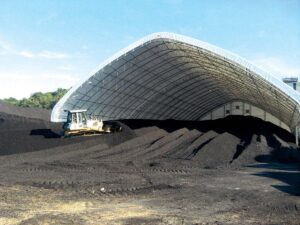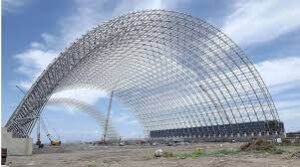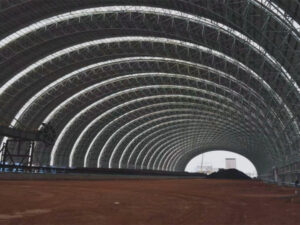Introduction to FGD Domes
Flue Gas Desulfurization (FGD) dome is integral to modern emission control systems, particularly in industries that burn fossil fuels. These domes shield FGD units from environmental elements and optimize the desulfurization process to remove sulphur dioxide (SO₂) from industrial emissions. As environmental scientist David Jones says, “Reducing emissions isn’t just a regulation to follow; it’s an obligation to the planet.” In this guide, we’ll break down the purpose, design, and impact of FGD dome on environmental compliance.
What is Flue Gas Desulphurization?
Flue Gas Desulphurization (FGD) is a technology used to eliminate sulphur dioxide (SO₂) from exhaust emissions. When fossil fuels are burned, they release SO₂, a significant contributor to air pollution and acid rain. FGD systems use chemical reactions to neutralize SO₂ before it reaches the atmosphere, thus protecting the environment and helping industries meet regulatory standards.
Types of FGD Domes
FGD dome come in various materials and designs tailored to specific industrial needs. Here are the main types:
- Aluminium Domes: Known for their corrosion resistance and lightweight properties.
- Concrete Domes: Highly durable and effective for long-term applications.
- Composite Material Domes: Combining different materials to balance strength and weight.
Each type has its benefits, but all are designed to withstand harsh conditions, reduce environmental impact, and protect FGD systems.
Structural Composition of FGD Domes
The structural makeup of FGD dome is critical to their functionality. They are often built with high-strength materials like aluminum alloys or reinforced concrete. Essential structural elements include:
- Geodesic Frames: Provides durability and stability with minimal material.
- Insulating Layers: Helps control internal temperature and prevent corrosion.
- Venting Systems: Ensures safe release of non-toxic gases.
This combination creates a resilient, long-lasting structure optimized for continuous industrial use.
Benefits of Using FGD Domes
FGD domes offer several advantages, making them a worthwhile investment:
- Protection from External Elements: Dome shield FGD systems from environmental wear, ensuring consistent functionality.
- Durability: High-quality materials mean domes have a long lifespan, reducing repair and replacement costs.
- Optimized Emission Control: Domes maintain the ideal conditions for efficient SO₂ absorption, improving overall system performance.
How FGD Domes Function in Emission Reduction
FGD dome create a controlled environment for the FGD system to operate efficiently. By covering the desulphurization unit, domes prevent external elements from disrupting the SO₂ removal process, while venting mechanisms allow safe expulsion of non-harmful gases. This setup is instrumental in minimizing SO₂ emissions and supporting industrial compliance with environmental standards.
Innovations in FGD Dome Design
The latest advancements in FGD dome technology focus on eco-friendly designs and sustainable materials. Lightweight, corrosion-resistant alloys and recycled composites are becoming popular, offering strength without sacrificing environmental responsibility. Innovations in modular construction also make dome installation faster and more cost-effective.
Technical Terms Associated with FGD Domes
To better understand FGD domes, here are a few key terms:
- Scrubbing: The process of treating flue gases to remove pollutants.
- Slurry: A mixture of water and absorbent material used in FGD systems to neutralize SO₂.
- Sorbents: Substances like limestone used to absorb sulphur compounds.
- Effluent: The treated flue gas that exits the FGD system, ideally low in SO₂ content.
Installation Process of FGD Domes
Installing an FGD dome involves several stages:
- Site Preparation: The ground must be leveled and reinforced to support the dome structure.
- Foundation Laying: Concrete or steel foundations are often used to anchor the dome.
- Frame Assembly: Geodesic or truss frames are assembled and secured.
- Panelling & Insulation: Dome panels and insulation layers are added.
- Testing & Inspection: A thorough inspection ensures the dome’s structural integrity and functionality.
Materials Used in FGD Dome Construction
FGD domes are typically made from:
- Aluminium Alloys: Lightweight and corrosion-resistant, ideal for harsh environments.
- Reinforced Concrete: Extremely durable but requires stronger foundation support.
- Fiberglas or Composites: These provide a balance between weight and strength, suitable for moderate conditions.
Each material has specific applications, chosen based on the industry’s needs and environmental exposure.
Maintenance of FGD Domes
Regular maintenance is essential for extending the life of an FGD dome:
- Inspection of Joints & Seals: Ensures that no leaks or gaps are allowing pollutants to escape.
- Cleaning & Debris Removal: Keeps the structure free from material build-up that could impact efficiency.
- Corrosion Checks: Helps detect and repair rust or erosion on metal surfaces.
Proper maintenance supports optimal emission control and ensures the FGD system remains compliant.
FGD Domes & Environmental Compliance
FGD dome plays a significant role in meeting environmental regulations. Industries that operate under strict emission standards often rely on FGD systems housed within domes to control SO₂ emissions effectively. With growing climate concerns, FGD dome contributes to sustainable practices by enhancing pollution control and ensuring regulatory compliance.
Challenges in FGD Dome Implementation
Despite their benefits, FGD domes come with some challenges:
- High Initial Cost: The materials and installation can be costly, though long-term savings in maintenance and fines often offset this.
- Complex Installation Process: Installing large dome structures requires specialized knowledge and equipment.
- Environmental Factors: In extreme climates, material durability can become a concern, requiring frequent inspections and maintenance.
By addressing these challenges, industries can maximize the lifespan and efficiency of FGD domes.
Future of FGD Domes in Industrial Emission Control
As emission standards tighten, FGD dome technology will continue to evolve. Future trends may include using renewable materials, advanced insulation for greater energy efficiency, and designs that adapt to varying environmental needs. The FGD dome represents a promising frontier in sustainable industrial practices.
Conclusion
FGD dome is an invaluable part of modern emission control, safeguarding our environment and supporting industries in achieving compliance. Their design and functionality allow industries to capture and neutralize harmful emissions efficiently. As technology advances, FGD domes are likely to become even more sustainable, playing a crucial role in future pollution management strategies.





